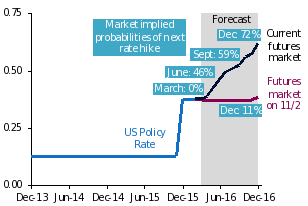Economic Commentary
After a tough start to the year, global financial markets have recovered strongly in recent weeks. Early in the year, a number of concerns plagued financial markets and pushed back expectations for increases in the US Federal Reserve’s (Fed) policy rate. However, more recently, the alleviation of these concerns and a recovery in financial conditions means that the Fed is now more likely to press ahead with rate hikes.
Global financial markets struggled at the beginning of 2016: the MSCI World equity index fell 11.5% in the first six weeks of the year with the worst losses in China, down more than 20%; the US S&P 500 index fell 10.5% over the same period; and oil prices fell 19.4%due to concerns about global demand and continued excess supply.
Markets were struck by a range of global economic concerns. First, in China, the devaluation of the renminbi and slowing growth raised the risk of further devaluations and runaway capital flight.Markets may also be concerned about the tail-risk of a full-blown balance of payments crisis. Second, a raft of negative data pointed to a slowdown in economic activity concentrated in the global manufacturing sector. Industrial production contracted in December in the world’s largest manufacturing hubs, the US, Japan and Eurozone. Q4 GDP growth collapsed to 0.7% in the US (later revised up to 1%) and -1.4% in Japan (later revised up to -1.1%). Third, lower oil prices raised the risk of credit events amongst oil producers that could destabilise financial markets.
One significant result of the turmoil in financial markets was that the Fed backed off on its rhetoric around the next rate hike. In her testimony to Congress on 10th February, Fed Chair, Janet Yellen, said that tightening financial conditions would need to be taken into account. Market expectations for rate hikes were substantially revised down, with only an 11% chance of a rate hike priced into financial markets for the whole of 2016.
Fed Policy Rate and Futures (%)

Sources: Bloomberg, Federal Reserve, Haver Analytics and QNB Economics
We wrote at the time that the market reaction to the economic data and events was overdone. See our commentaries on the risks emanating from China (China’s devaluation creates spillover risks in some EMs) and our view on the disappointing global data (Are markets overreacting to weak global economic data?). It does now appear that concerns about China and the global economy have eased. Global equity markets have recovered some ground from their lows. The MSCI world equity index is now only 3.6% down for the year, the S&P is 2.7% down and oil prices are up 9.8%. Meanwhile, Chinese equity markets are down 18.0% for the year. The Chinese authorities have reversed their exchange rate policy, letting the renminbi appreciate and calming capital flight concerns. And, finally, GDP growth is now expected to rebound in Q1 2016 in the US (2.0% consensus forecast) and Japan (1.2% consensus forecast). Recent data also suggests that consumption in the US is beginning to pick up with stronger retail sales, consumption and consumer confidence data.
Two key data points for the Fed have also come in stronger than expected in the last two weeks, strengthening the case for the Fed to raise interest rates. First, core inflation rose to 1.7% in January, nearing the Fed’s 2% target and compared with expectations of 1.5%. Second, nonfarm payrolls came in much stronger than expected at 242k in February, keeping unemployment down at 4.9% and providing a further indication of the strength of the US labour market. Futures markets have re-priced to incorporate the increased likelihood of a Fed rate hike. A hike on March 16th remains highly improbable given the recent financial turmoil and without more data to confirm the economy is back on track. However, current futures markets imply a 46% probability of a 25bps rate hike by June and 72% by December.
In a commentary in mid-February, we postulated that the Fed would press ahead with rate hikes if markets stabilised (How many times should the Fed hike rates this year?). Now that global financial markets have stabilised, a rate hike this coming June does seem to be firmly back on the cards. In December, the Fed reckoned it would hike rates four times in 2016. Markets now expect one hike by the end of the year, up from zero at the peak of the market turmoil. The truth is likely to be somewhere in the middle, so, if the current relative calm in financial markets persists, then we can expect two or three rate hikes this year.
